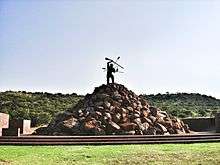Battle of Vegkop
The Battle of Vegkop, alternatively spelt as Vechtkop, took place on 16 October 1836 near the present day town of Heilbron, Free State, South Africa. After an impi of about 600 Matebele murdered 15 to 17 Afrikaner voortrekkers on the Vaal River, abducting three children, King Mzilikazi (c. 1790 – 9 September 1868; also known as Mzilikazi, Oemsiligasi or Moselekatse, or, in Afrikaans, Silkaats) ordered another attack. The voortrekkers, under the command of Andries Potgieter, repulsed them, but at the cost of abandoning their livestock.
| Battle of Vegkop | |||||||
|---|---|---|---|---|---|---|---|
| Part of the Great Trek | |||||||
 Vegkop Battlefield Monument outside of Heilbron | |||||||
| |||||||
| Belligerents | |||||||
|
| Matabele | ||||||
| Commanders and leaders | |||||||
| Andries Potgieter | King Mzilikazi | ||||||
| Strength | |||||||
| 35 mounted infantry | about 5,000 infantry | ||||||
| Casualties and losses | |||||||
| 2 dead | 184 dead | ||||||
Attack on the camp
On 9 October, King Mzilikazi sent an army of 5,000 Matabele warriors to attack the voortrekkers. About one third of these, however, were slaves whose motivation was simply to steal cattle. The voortrekkers had been warned by Betsjoena or Bataoeng bushmen about the impi's arrival two days beforehand. So they secured their laager by placing the 50 wagons in a circle and filling the spaces underneath and between them with thorn branches to prevent the attackers from crawling through. There were only 35 men to defend it.
On the morning of the attack, the farmers went out to meet the enemy, in the hope of driving back the Matebele and thus avoiding a direct attack on the camp. The voortrekkers were on horseback and armed with guns, whereas the Matebele were on foot and armed only with spears and shields, but this imbalance did not prevent the Matabele from advancing slowly towards the camp. By about 3 p.m. the farmers had returned to the camp. Blockaded in, they prepared to defend themselves with a ratio of 1 voortrekker to every 150 Matabele warriors.
The Matebele stood just beyond striking distance, and then positioned themselves on either side of the camp before rushing on it in a pincer movement. Some tried to crawl through the thorn branches, trying to cut off the leather straps that tied them; others threw their spears into the camp. After a few minutes, the Matabele were so badly wounded that they fled. Two farmers and 184 Matebele died. In spite of their loss, the spoil was great: The Matebele plundered 50,000 sheep and goats and 5,000 cattle, including all their draft cattle.
Aftermath
The Tswana (Rolong) people assisted the voortrekkers in recovering some of their cattle, but revenge attacks were also planned. On 17 January 1837, voortrekkers under the command of Hendrik Potgieter and Gerrit Maritz destroyed the town of Mosega, recovering about 6,000 cattle. In total, 15 or 16 settlements were destroyed and more than 1,000 of King Mzilikazi's warriors were killed. This was followed by the Battle of Gabeni from 4-13 November 1837, led by Potgieter and Uys.
The Marico region was eventually evacuated by the Matabele population when, in 1838, about 15,000 of them traveled across the Limpopo River to settle further north in Modern-day Matabeleland in Zimbabwe.
The three abducted children were never seen again.